
Insignias and badges of the United States Navy are military badges issued by the United States Department of the Navy to naval service members who achieve certain qualifications and accomplishments while serving on both active and reserve duty in the United States Navy. Most naval aviation insignia are also permitted for wear on uniforms of the United States Marine Corps.

Bruce Estes Grooms, is a retired vice admiral in the United States Navy. His last duty station before retirement was as Deputy Chief of Staff for Capability Development at Allied Command Transformation. He retired in June 2015.
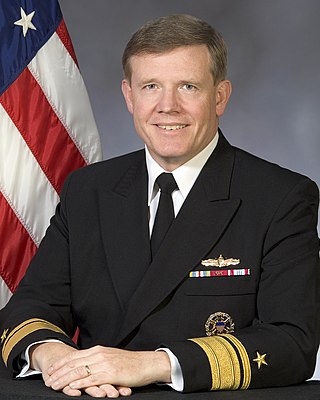
Rear Admiral Robert Dunham Reilly Jr. was a United States Navy Surface Warfare Flag Officer who retired from active duty in January 2010 after 34-plus years of military service. His last assignment was as the 24th commander of the U.S. Navy's Military Sealift Command (MSC).
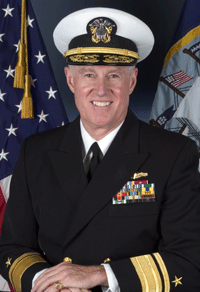
Rear Admiral William VanMeter Alford Jr. was the chief of staff for the United States Pacific Command between August 2004 and September 2007.

The United States Fleet Marine Forces (FMF) are combined general- and special-purpose forces within the United States Department of the Navy that perform offensive amphibious or expeditionary warfare and defensive maritime employment. The Fleet Marine Forces provide the National Command Authority (NCA) with a responsive force that can conduct operations in any spectrum of conflict around the globe.
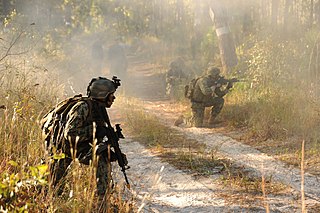
The EXW qualification is a warfare qualification awarded to enlisted United States Navy personnel assigned to U.S. Navy expeditionary combat units, who satisfactorily complete the required qualification course and pass a qualification board hearing. The program was approved July 31, 2006 by then-Chief of Naval Operations Adm. Michael Mullen.

The United States Marine Corps is organized within the Department of the Navy, which is led by the Secretary of the Navy (SECNAV). The most senior Marine commissioned officer is the Commandant of the Marine Corps, responsible for organizing, recruiting, training, and equipping the Marine Corps so that it is ready for operation under the command of the unified combatant commanders. The Marine Corps is organized into four principal subdivisions: Headquarters Marine Corps, the Operating Forces, the Supporting Establishment, and the Marine Forces Reserve.
The structure of the United States Navy consists of four main bodies: the Office of the Secretary of the Navy, the Office of the Chief of Naval Operations, the operating forces, and the Shore Establishment.

Rear Admiral Jay Allan DeLoach served as the Director of Naval History and Director of the Naval History and Heritage Command and the Curator of the Navy from 2008 to 2012. He was an American submarine officer who played a role in implementing a visionary "Memorandum of Understanding" between the Submarine Force Active component and the Reserve component. He helped pioneer many key initiatives that have since been adopted Navy-wide. DeLoach was the Assistant Deputy Chief of Naval Operations for Resources, Requirements and Assessments.
Hispanic and Latino Admirals in the United States Navy can trace their tradition of naval military service to the Latino sailors, who have served in the Navy in every war and conflict since the American Revolution. Prior to the Civil War, the highest rank reached by a Latino-American in the Navy was commodore. Such was the case of Commodore Uriah Phillips Levy (1792–1862), a Sephardic Jew of Latin American descent and great grandson of Dr. Samuel Nunez, who served in the War of v. During the American Civil War, the government of the United States recognized that the rapid expanding Navy was in need of admirals therefore, Congress proceeded to authorize the appointment of nine officers the rank of rear admiral. On July 16, 1862, Flag Officer David Glasgow Farragut became the first Hispanic-American to be appointed to the rank of rear admiral. Two years later (1864), Farragut became a vice admiral, and in 1866 the Navy's first full admiral. During World War I, Robert Lopez, the first Hispanic graduate of the United States Naval Academy, served with the rank of commodore in command of the Mare Island Naval Shipyard, and during World War II five Hispanics served with the ranks of rear admiral or above in either the European or Pacific Theaters of the war. As of April 2007, twenty-two Hispanic-Americans have reached the rank of admiral, and of this number thirteen were graduates of the USNA.
Hispanics in the United States Naval Academy account for the largest minority group in the institution. According to the academy, the Class of 2009 includes 271 (22.2%) minority midshipmen. Out of these 271 midshipmen, 115 are of Hispanic heritage. In 2004, of the total of 736 female midshipmen, 74 (10%) of them were of Hispanic descent.

Admiral Robert Joseph Natter is a retired United States Navy admiral who served as Commander, U.S. Atlantic Fleet/Fleet Forces Command from 2000 to 2003.
The Naval Coastal Warfare community is a component of the United States Navy, part of Naval Expeditionary Combat Command. The Maritime Expeditionary Security Force (MESF), formerly known as the Mobile Security Forces (MSF), has the primary mission of force protection conducted through fleet support with operations around the world. Anti-Terrorism and Force Protection missions include harbor and homeland defense, coastal surveillance, and special missions.

Patrick Hahler Brady is a retired United States Navy rear admiral who in July 2007 became the first person of Hispanic descent to be named commander of the Naval Undersea Warfare Center. At the time, he was one of four admirals of Hispanic descent who were serving in the United States Navy. He later served four years as head of the Space and Naval Warfare Systems Command.
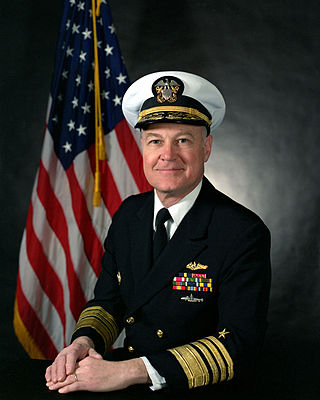
Henry Goodman Chiles Jr. is a retired United States Navy four star admiral who served as Commander in Chief, United States Strategic Command (USCINCSTRAT), from 1994 to 1996, the first naval officer to command all of the strategic nuclear forces of the United States.
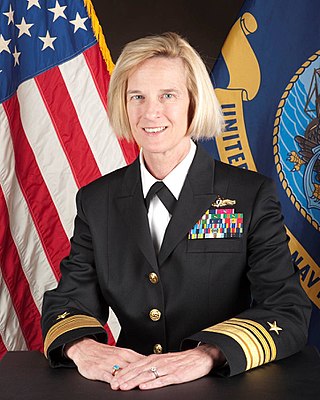
Carol M. Pottenger is a retired United States Navy flag officer. She was among the first women to be assigned to serve at sea in 1978, the first female admiral to command a major combat organization, Amphibious Force 7th Fleet/Expeditionary Strike Group Seven, encompassing the amphibious forces assigned to the western Pacific; and the first female admiral to lead a combatant force "type command", Navy Expeditionary Combat Command, charged with the manning, training and equipping of over 40,000 expeditionary sailors in preparation for combat deployments to Iraq and Afghanistan, as well as global security assistance operations. Her final naval post was with NATO as deputy chief of staff for capability and development at Supreme Allied Commander Transformation, Norfolk, Virginia, the first female officer to hold this position.
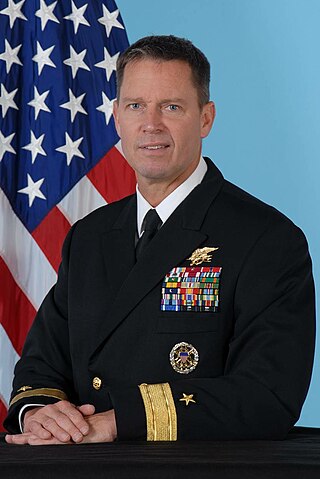
Thomas L. Brown II was a retired United States Navy officer and the first Navy officer to command Special Operations Command South, based in Homestead Joint Air Reserve Base, Florida.
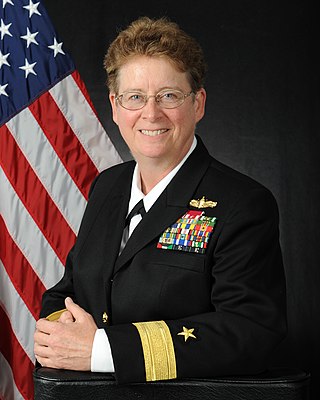
Sandra Elizabeth Adams is a retired rear admiral in the United States Navy.

Rear Admiral Kenneth R. Blackmon is a reserve United States Navy officer who has been serving as Reserve Director of Maritime Operations, United States Fleet Forces Command since October 1, 2021.














